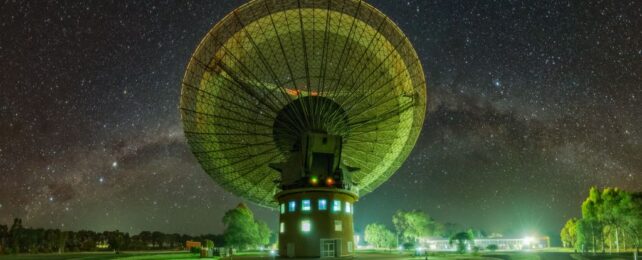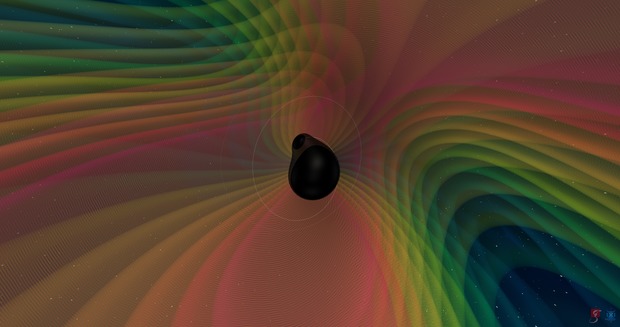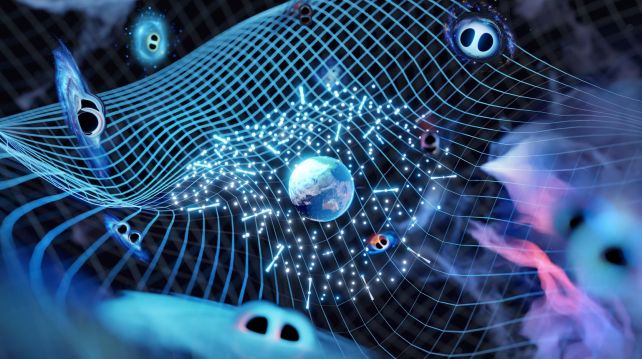BREAKING NEWS: Physicists Have Detected The Background Hum of The Universe
 The Murriyang radio telescope on Wiradjuri Country at Parkes, Australia. (Alex Cherney)
The Murriyang radio telescope on Wiradjuri Country at Parkes, Australia. (Alex Cherney)
It's official. There's something out there shaking the stars in a way that can no longer be ascribed to chance.
Several teams around the world have independently found a signal in the timing of flashing stars called pulsars that points to giant, long-wavelength gravitational waves rolling through the galaxy. It's not quite a detection of those gravitational waves yet – but there is more than a 99 percent chance that what we're looking at is something significant.
Teams in Australia, the US, Europe, China, and India are releasing their results simultaneously in a slew of papers.
"We've been on a mission for the last 15 years to find a low-pitch hum of gravitational waves resounding throughout the Universe and washing through our galaxy to warp space-time in a measurable way," astrophysicist Stephen Taylor of Vanderbilt University and chair of NANOGrav, the team in the US, said in a press briefing.
"We're very happy to announce that our hard work has paid off, and … we have exciting evidence of this background of gravitational waves."
Gravitational wave astronomy is a relatively new field, following the detection of space-time ripples caused by two colliding black holes in 2015. Since then, our Earth-based gravitational wave detectors have picked up nearly 100 confirmed gravitational wave events at the time of this writing, all created by mergers of compact stellar-mass objects – black holes and neutron stars.

Gravitational waves are caused by massive events in the Universe. Imagine a collision between black holes as a rock thrown in a pond and gravitational waves as the ripples generated. The medium is space-time itself, and the ripples, traveling at the speed of light, propagate out in all directions, stretching and squeezing space-time in a way we can detect. We have explained all the background in greater detail here if you want to dive deeper.
Now imagine how many black holes must be colliding across the Universe. And how many other massive events must be generating these ripples. Space-time should be absolutely humming with gravitational waves, but there's a problem. Earth is simply too small to detect them at the longer wavelengths on the nanohertz scale that can extend for lightyears, those expected of more massive events, like the mergers of the supermassive black holes at the centers of galaxies.
Luckily, however, we live in a galaxy that is much bigger than Earth. And there's something in our galaxy that emits very precisely timed signals that can be affected by nanohertz gravitational waves: radio pulsars. These are neutron stars that rotate extremely fast, with jets of radio light erupting from their magnetic poles. As they rotate, these beams sweep past Earth like a cosmic lighthouse, and because the timing of these pulses is so precise, we can use them to detect the way space stretches and squeezes as gravitational waves roll through.
One minor glitch in the timing is not enough. But if you have enough pulsars with correlated glitches over a long enough time frame, you can compile evidence of a large gravitational wave. This is what the different teams around the world did, studying a total of 115 pulsars between them, for up to 18 years for the Parkes Pulsar Timing Array in Australia.
"A pulsar timing array is a galactic-scale gravitational wave detector. We have detected a common 'rumble' among the pulsars in our array – a signal at ultra-low frequencies," astrophysicist Daniel Reardon of the PPTA and Swinburne University in Australia tells ScienceAlert.
"We, along with our international colleagues, are now also seeing a hint of the fingerprint that identifies this rumble as originating from gravitational waves."
We've had hints of this signal before. In January 2021, NANOGrav published a paper detailing what they thought was the first hint of the gravitational wave background in their pulsar timing data. In January 2022, the International Pulsar Timing Array followed suit with its set of pulsars.
Now, after painstaking work to determine that the signal was not generated by the pulsars or other noise in the data, researchers have concluded that the signal is significant.
NANOGrav's signal has a confidence level of 4 sigma across 67 pulsars, or 99.349 percent. The PPTA's signal has a lower confidence level because it studied fewer pulsars; their detection is based on just 30 stars but over a longer period. The gold standard for a discovery is 5 sigma. So there's still a lot of work to be done.

"This is not a detection of gravitational waves yet," Reardon says. "This fingerprint will need to become clearer, for example, by using more data, to confirm this as a gravitational wave detection. But this is very exciting nevertheless because the fingerprint was expected to emerge slowly in our data sets, as it appears to be doing with the evidence observed by the collection of pulsar timing array collaborations."
Because it's not yet a confirmed gravitational wave detection, the researchers can't say conclusively what's causing it. The most obvious answer is supermassive black holes. Supermassive black hole mergers ought to occur at a rate that fills the Universe with gravitational wave noise, like the rumble of the sea.
It's not the only potential source of the gravitational wave background. Cosmic strings, phase changes in the Universe, the rapid inflation of space that followed the Big Bang – all these could produce low-frequency gravitational waves. (The Big Bang may have as well, but the wavelength would be the size of the Universe – something we definitely don't have a big enough detector for.)
What we're probably looking at right now is the supermassive black hole background.
"We know that every large galaxy has a supermassive black hole at its core. We also know that galaxies collide, and when they do, we expect the supermassive black holes to sink to the center and begin whirling around one another, emitting gravitational waves," Reardon explains.
"The further away we look in the Universe, the more of these supermassive black hole systems we can see. A very large population of orbiting supermassive black holes in the distant Universe creates a random ocean of gravitational waves that wash over Earth and the pulsars in our galaxy."
Pulsar timing array astronomy is a long game, but we're close to the confirmed signal. The separate pulsar timing arrays around the world have now combined their datasets and are working to corroborate their findings under the IPTA collaboration. This confirmation should come within a year, perhaps two at a stretch.
Then, a bold new era of nanohertz gravitational wave astronomy can begin. The researchers will be able to tease apart the signal, study its characteristics, and work out the sources of the massive gravitational disruptions booming across space. From there, we may even begin to probe, in greater detail than ever before, the properties of supermassive black holes.
"These pulsar timing array works are the first hints at nanohertz-frequency gravitational waves," Reardon tells ScienceAlert.
"To imagine that the Universe is really a rumbling ocean of stretching and squeezing space is incredible. Supermassive black holes are cosmic behemoths at the hearts of galaxies that feed on gas and disrupt star formation. I'm excited for a future where our pulsar observations reveal an intricate map of gravitational waves rippling from pairs of supermassive black holes. We should see the background hum of the Universe with pinpointed 'hot spots' of gravitational waves from individual pairs of supermassive black holes lying in galaxies that we can identify."
The PPTA's papers are due to be published in The Astrophysical Journal Letters and Publications of the Astronomical Society of Australia. NANOGrav's five papers will be appearing in The Astrophysical Journal Letters. The Chinese Pulsar Timing Array's work appears in Research in Astronomy and Astrophysics.
We will add links to more papers as they become available.
For particularly regular pulsars, those pulses are as regular as, or more regular than, our best atomic clocks! Now a gravitational wave arrives. You might have seen animations of what gravitational waves do. If you make a circle out of freely floating particles, then a 4/
— Markus Pössel (@mpoessel) June 25, 2023









0 Comments
Yorum ekle